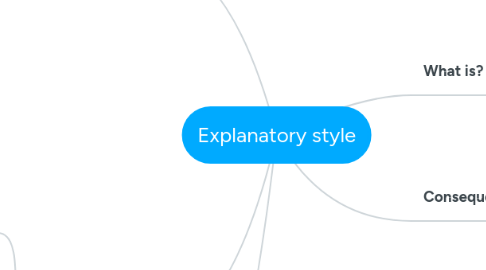
1. What is?
1.1. Habits of explanation
1.1.1. How do you think about failure?
1.1.2. What do you think of yourself when you encounter a wall?
1.2. Way we live our lives
2. Consequences
2.1. Influence the way other people see you
2.1.1. Work with you
2.1.2. Work against you
2.2. Learned helplessness
2.2.1. Rumination
2.2.1.1. Depression
2.2.1.1.1. WHEN PEOPLE ARE DEPRESSED, THEY ARE ALSO PESSIMISTIC
3. How to change it?
3.1. Recognizing automatic thoughts at the times you feel worst
3.1.1. Dispute
3.1.1.1. Contrary evidence
3.1.2. Distraction
3.1.2.1. Attention shifting techniques
3.1.2.1.1. Schedule a specific time to give your problems a thought
3.1.2.1.2. Focus attention on a small object
3.1.2.1.3. Hitting a rubber band in the wrist
3.1.3. Keep going or give up?
3.2. Optimistic personal dialogue
3.2.1. ABCDE method
3.2.1.1. A: Adversity
3.2.1.1.1. Description of what happened
3.2.1.2. B: Belief
3.2.1.2.1. How you interpret the adversity
3.2.1.3. C: Consequence
3.2.1.3.1. Feelings (sad, anxious, guilty, joyful), what you did
3.2.1.4. D: Disputing
3.2.1.4.1. Evidence
3.2.1.4.2. Alternatives
3.2.1.4.3. Implications
3.2.1.4.4. Usefulness
3.2.1.5. E: Energization
4. Dimensions
4.1. Permanence
4.1.1. "It's gonna last forever"
4.1.2. "It's only temporal"
4.2. Pervasiveness
4.2.1. "It's gonna undermine everything I do"
4.2.2. "Every aspect of my life is wrong"
4.2.3. "A specific aspect of my life is not doing well"
4.3. Personalization
4.3.1. "It's because of me"
4.3.2. "The circumstances that made me fail are outside of my reach"
5. Where does it come from?
5.1. Mother's explanatory style
5.1.1. The mother’s level of optimism and the child’s level were very similar.
5.1.2. Most influential people in a child's life
5.2. Adult's criticism
5.2.1. Permanent and pervasive explanation of a kid's failure
